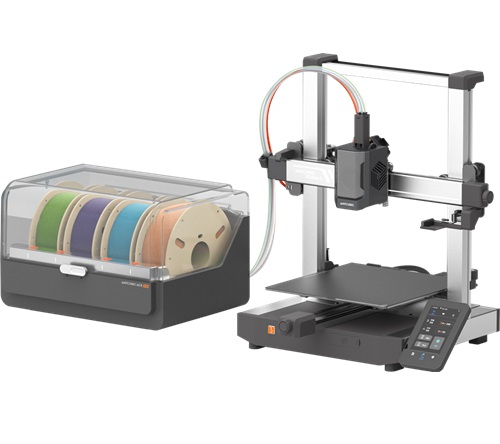Compare Kobra 3 Combo vs CR 10 Smart Pro
Comparison between the best 3D printers
Choose the best 3D printer at the best price. The cheapest 3D printers are here.
Buy a 3D printer here with 3D Fila.
 |
 |
|
| Model | Kobra 3 Combo[BUY Kobra 3 Combo] |
CR 10 Smart Pro[BUY CR 10 Smart Pro] |
| Printing Material | Filament | Filament |
| Buy Filament for Anycubic Kobra 3 Combo | Buy Filament forCreality 3D CR 10 Smart Pro | |
| Estimated price | $349,00 | $900,00 |
| Manufacturer | Anycubic | Creality 3D |
| Release Year | 2024 | 2020 |
| Print Volume [mm] | 250x250x260 | 300x300x400 |
| Printer Size [mm] | 452x504x483 | 578x522x648 |
| Weight [kg] | 9,2 | 13,6 |
| Power Loss Recovery | YES | YES |
| Enclosed printer | NO | NO |
| Bed Leveling | Automatic | Manual |
| Filament End Sensor | YES | YES |
| Bed type | Heated | Heated |
| Power supply system | Direct Drive | Bowden |
| Standard nozzle | 0,4 | 0,4 |
| Maximum Nozzle Temperature [°C] | 300 | 300 |
| Maximum Bed Temperature [°C] | 110 | 100 |
| Maximum printing speed [mm/s] | 600 | 50 |
| Filament holder | YES | YES |
| Camera for supervision | NO | NO |
| Recommended filaments | PLA, PETG, ABS, PP, HIPS | PLA, PETG, Tritan, Flex, ABS |
| Recommended slicers | Anycubic Slicer, Cura, Orca Slicer | Cura, Simplify, Slic3r, IdeaMaker |
| Maximum Resolution [mm] | 0,1 | 0,1 |
| Processor | 32 bits | |
| Display | Touchscreen 4,3'' | Display touchscreen 4,3'' |
| Power Supply | 400 W | 110/220V / 350W |
| Connectivity | USB, Wi-Fi, Cloud | SD / USB / Wi-Fi / Ethernet |
| Operating systems | Windows, Linux, Macbook | Windows, Mac, Linux |
| Date of registration in the system | 2024-06-27 | 2022-11-04 |
| Release date | 2024 | 2020 |
| Extra features | The Anycubic Kobra 3 Combo offers advanced features, including multi-filament printing with the ACE (Anycubic Color Engine) system, allowing for quick switching of up to four filaments. It features automatic bed leveling, nozzle clogging detection, and integrated filament drying during printing. The printer supports technical materials such as ABS, ASA, Nylon, and PC, thanks to the hotend that reaches 300°C and the heated bed up to 110°C. In addition, it has a 4.3-inch touchscreen and compatibility with various slicers such as Anycubic Slicer, Cura, and Orca Slicer. | Creality's CR-10 Smart Pro printer offers a large 300x300x400mm build volume, Sprite Pro direct extruder for multiple materials, CR Touch auto-leveling, PEI magnetic bed, 4.3" touchscreen, LED lighting, and Creality Cloud connectivity. Some areas of improvement include the use of brass spindle nuts and tinned wires. |
| Support for multiple colors and materials (AMS and CFS) | YES | NO |
Notes * |
||
| Cost-benefit | 8 / 10 | 6 / 10 |
| Hardware | 4 / 10 | 2.5 / 10 |
| Tela | . | . |
| Print volume | 4 / 10 | 4 / 10 |
| Performance | 5 / 10 | 1 / 10 |
| [BUY Kobra 3 Combo] | [BUY CR 10 Smart Pro] |
Conclusion |
| In comparing the Anycubic Kobra 3 Combo and the Creality 3D CR-10 Smart Pro, we find distinct advantages and disadvantages that cater to different user needs and price considerations. The Kobra 3 Combo, with its lower price point, offers an impressive range of features, particularly for those interested in advanced multi-filament printing capabilities, alongside benefits such as automatic bed leveling, filament drying, and a higher maximum printing speed. This model excels in versatility and user-friendliness, making it an ideal choice for hobbyists and those new to 3D printing. Its compact design and lighter weight also make it easier to manage in smaller spaces. On the other hand, the CR-10 Smart Pro, while more expensive, boasts a larger print volume which may appeal to professional users or those requiring more extensive production capabilities. However, its manual bed leveling process and lower maximum printing speed could be seen as drawbacks for more casual users seeking efficiency. Additionally, while it offers quality support for multiple materials, it lacks some of the advanced features present in the Kobra 3 Combo. Ultimately, the Kobra 3 Combo represents a compelling cost-benefit ratio, particularly for those looking to explore 3D printing without a significant financial commitment. In contrast, the CR-10 Smart Pro, despite its higher price tag, may serve better for users needing a larger build area and willing to trade off some convenience features. The decision should hinge on individual priorities—whether that’s advanced features and ease of use, or a larger scale of production capabilities. |

